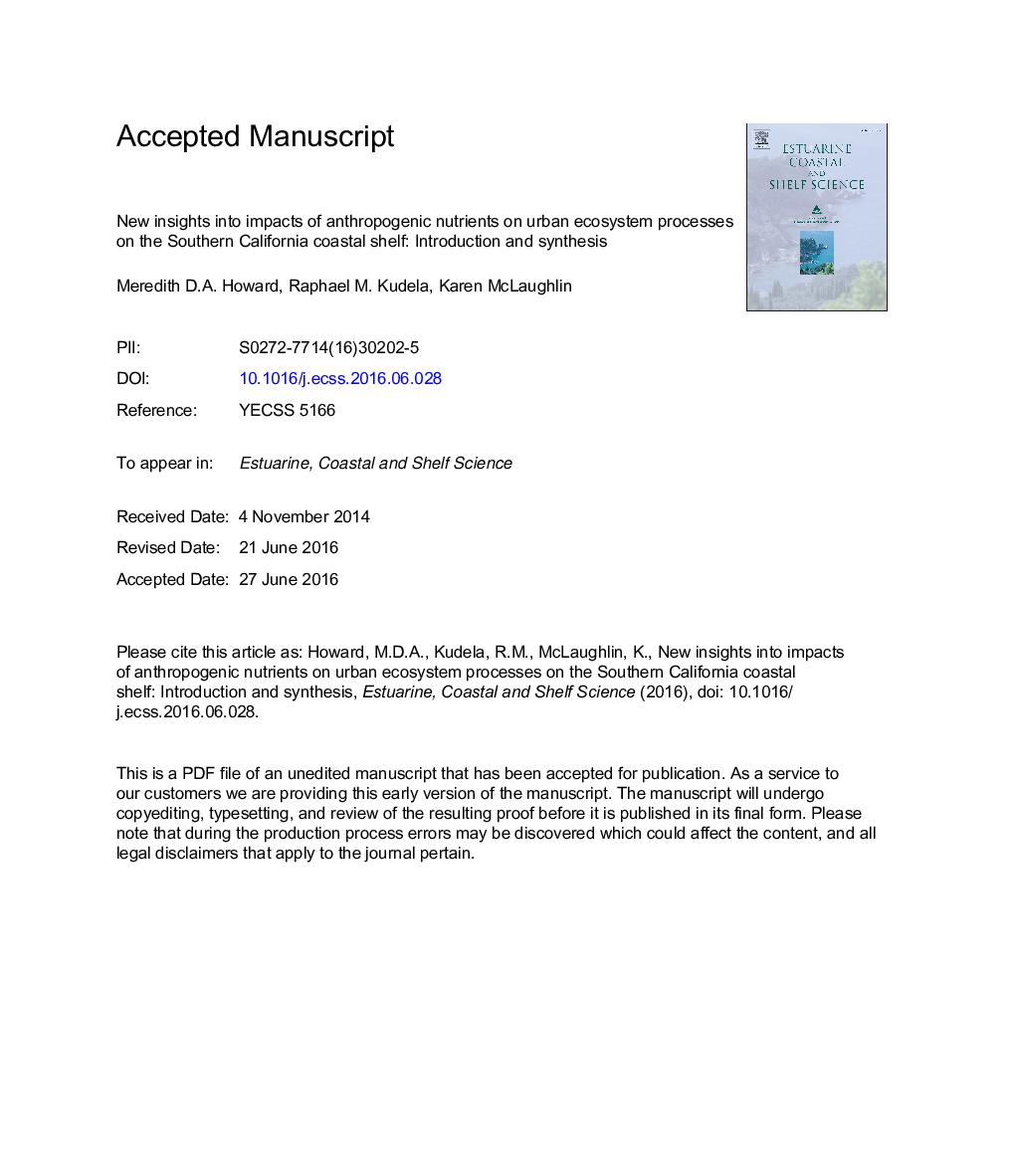| کد مقاله | کد نشریه | سال انتشار | مقاله انگلیسی | نسخه تمام متن |
|---|---|---|---|---|
| 5765177 | 1413060 | 2017 | 28 صفحه PDF | دانلود رایگان |
عنوان انگلیسی مقاله ISI
New insights into impacts of anthropogenic nutrients on urban ecosystem processes on the Southern California coastal shelf: Introduction and synthesis
ترجمه فارسی عنوان
بینش جدید درباره تاثیرات مواد مغذی انسان در فرآیندهای اکوسیستم شهری در قفسه سواحل جنوبی کالیفرنیا: مقدمه و سنتز
دانلود مقاله + سفارش ترجمه
دانلود مقاله ISI انگلیسی
رایگان برای ایرانیان
کلمات کلیدی
فاضلاب، مواد مغذی آنتروپنی حلقه میکروبی، فیتوپلانکتون، چرخه بیوگرافی شیمیایی، نیتروژن،
موضوعات مرتبط
مهندسی و علوم پایه
علوم زمین و سیارات
زمین شناسی
چکیده انگلیسی
Anthropogenic nutrient inputs are one of the most important factors contributing to eutrophication of coastal waters. Coastal upwelling regions are naturally highly variable, exhibiting faster flushing and lower retention times than estuarine systems. As such, these regions are considered more resilient to anthropogenic influences than other coastal waters. Recent studies have shown our perception of the sustainability of these systems may be flawed and that anthropogenic nutrients can have an impact at local and regional spatial scales within these larger upwelling ecosystems. Maintenance of an outfall pipe discharging wastewater effluent to the Southern California Bight (SCB) provided an opportunity to study effects of anthropogenic nutrient inputs on a near-shore coastal ecosystem. The diversion of wastewater effluent from a primary, offshore outfall to a secondary, near-shore outfall set up a large-scale, in situ experiment allowing researchers to track the fate of wastewater plumes as they were “turned off” in one area and “turned on” in another. In this introduction to a special issue, we synthesize results of one such wastewater diversion conducted by the Orange County Sanitation District (OCSD) during fall 2012. Anthropogenic nitrogen (N) from point-source discharges altered biogeochemical cycling and the community composition of bacteria and phytoplankton. Nitrification of ammonium to nitrate in wastewater effluent close to outfalls constituted a significant source of N utilized by the biological community that should be considered in quantifying “new” production. The microbial-loop component of the plankton community played a significant role, exemplified by a large response of heterotrophic bacteria to wastewater effluent that resulted in nutrient immobilization within the bacterial food web. This response, combined with the photosynthetic inhibition of phytoplankton due to disinfection byproducts, suppressed phytoplankton responses. Our findings have ramifications for future studies and regulatory monitoring, emphasizing the need to consider chemical and biological responses to wastewater effluent in assessing effects of anthropogenic nutrient inputs on urbanized coastal ecosystems.
ناشر
Database: Elsevier - ScienceDirect (ساینس دایرکت)
Journal: Estuarine, Coastal and Shelf Science - Volume 186, Part B, 15 February 2017, Pages 163-170
Journal: Estuarine, Coastal and Shelf Science - Volume 186, Part B, 15 February 2017, Pages 163-170
نویسندگان
Meredith D.A. Howard, Raphael M. Kudela, Karen McLaughlin,
